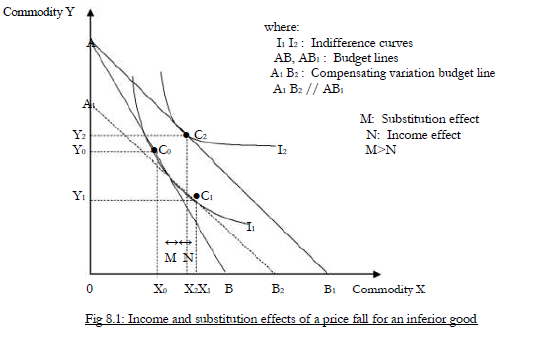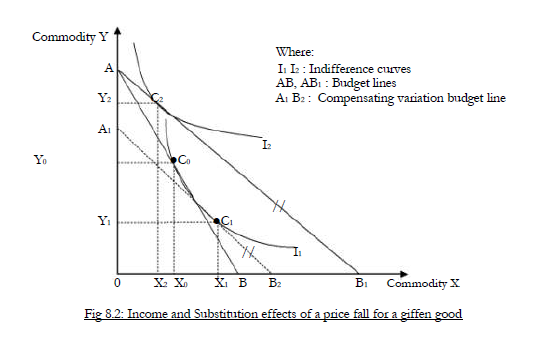Substitution effect is the change in the quantity demanded of a commodity due to change in the relative prices of the commodities, real income of the consumer remaining constant. Income effect refers to the change in the quantity demanded of a commodity arising from change in real income (purchasing power of money income) relative prices remaining constant. An inferior good is one whose consumption is due to the inability of the consumer to afford close substitutes; consumption of inferior goods decreases with increase in income.

The initial consumer equilibrium is at point C0 with X0 units of commodity X and Y0 units of commodity Y. A fall in price of commodity X has an effect of rotating the budget line outwards from AB to AB1. . This is due to the total price effect which involves both income and substitution effects. To be able to distinguish between the impact of change in real income (income effect) and that of substitution (substitution effect) on the quantity demanded, a compensating variation budget line A1 B2
tangent to the original indifference curve I1 at point C1 and parallel to the budget line AB1 is introduced, on the assumption that accompanying the price fall is a compensating variation of money income (eg. an upward adjustment of tax or reduction of a subsidy) such that the real income of the consumer remains unchanged (income effect is held constant) and thereby enabling for the isolation and estimation of the impact of substitution (substitution effect) of a price fall, represented by the movement from consumer equilibrium C0 to C1 that is X0 X2 of X on the X-axis
However, the compensating variation is a device which enables the isolation of the substitution effect, but does not show the ultimate equilibrium of the consumer. This ultimate equilibrium is determined by the nature of the commodity whose price has changed (fallen in this case) i.e. normal, inferior or giffen. For an inferior good, less is demanded (commodity X) as the purchasing power increases due to the price fall, although the substitution effect still remains positive.
Nevertheless, for most inferior goods the negative income effect will more than offset the positive substitution effect so that the total price effect will be negative. Again, although the income effect of most inferior goods is negative, there may still be a positive substitution effect stronger enough to allow for a downward sloping (normal) demand curve. Thus the positive substitution effect is in most cases adequate for establishing the law of demand; but where the income effect is negative and very strong the law of demand does not hold (instead we have a regressive demand curve). In figure 8.1 the income effect of the price fall is represented by (X2 X1 ) units of commodity X and the substitution effect is given by ( X0 X2 ) units of
commodity X. The negative income effect of the price fall moves the ultimate consumer equilibrium to C2
where more of commodity Y is consumed by reducing the consumption of commodity X from X1 to X2 .
Overall, since the positive substitution effect is greater than the negative income effect, consumption of X
increases from X0 to X2 Units.

In the case of a giffen good, the positive substitution effect (represented by X0 X1 of X) is more than offset by the negative income effect (represented by X2 X1 of X) which moves the ultimate consumer equilibrium to point C2 where more of Y and less of X is demanded; thus a fall in price of a giffen good (eg. X) causes a fall in quantity demanded, and the representative demand curve is regressive/reverse.
Wilfykil answered the question on
February 7, 2019 at 10:06